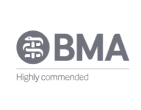Identifying non-food triggers for headaches
In addition to food, there are many other triggers that have been associated with headaches. In this article, we will review the six most common non-food triggers:
- Hormones
- Exercise
- Stress
- Environment
- Sleep
- Oral structures
Hormone fluctuations can trigger headaches
Due to hormone fluctuations, there is an increased incidence of headaches in women. The female sex hormones—estrogen and progesterone—are linked to headaches. A decrease in estrogen levels is a common headache trigger.
Menses is often associated with headaches because of decreasing estrogen levels.
Hormone replacement therapy and oral contraceptives can exacerbate headaches or change the characteristics and frequency of headaches.
In pregnancy, headaches frequently increase during the first trimester then dissipate during the last two trimesters, possibly due to sustained high estrogen levels.
Exercise affects the likelihood of suffering from a headache
There is only limited evidence suggesting that exercise can influence the development of headaches. That said, a lack of regular exercise can trigger headaches, and regular exercise can potentially decrease headache frequency.
Exercise may reduce muscle tiredness and muscle tension, both of which can trigger headaches. As well, regular exercise improves energy levels, promotes better sleep, reduces stress, and improves body aches and pains. For instance, we know exercise benefits fibromyalgia body and muscle aches.
However, exercise is difficult for many to begin and sustain. Setting realistic goals and advocating for a simple program is helpful. For example, 20–30 minutes three times per week is a good starting point. Encourage a well-rounded program that includes aerobic activity, light weightlifting, and stretching.
Stress influences the frequency and severity of headache attacks
As mentioned in the previous article, there is no clear evidence that stress causes—or is a direct factor—in the development of headaches. However, there is a perception that stress influences the frequency and severity of headache attacks.
Stress has been defined as a state when perceived demands exceed perceived resources. When we are stressed, our bodies respond by increasing cortisol levels (the stress hormone), but the possible role of cortisol in headache induction is unclear. Studies in this area have been difficult to perform.
Treatments such as cognitive behavioral therapy, biofeedback, meditation, and hypnosis can help with headache prevention.
Environmental factors can trigger headaches
Some environmental factors can cause headaches. For example, reduced atmospheric pressure has been associated with headaches. Patients may note that their headaches increase with storms, rapid weather shifts, and seasonal changes.
Excessive exposure to sunlight (e.g., more than three hours) may trigger headaches in some patients, even if they do not experience photophobia.
Frequently, patients report that exposure to cigarette smoke and strong odors (e.g., perfumes or cosmetics) can trigger headaches.
Many patients also report that loud noises can trigger their headaches. Such data is often gained from headache diaries.
Sleep habits can affect the likelihood of suffering from a headache
The relationship between sleep and headaches is complicated. Headache pain can interfere with sleep in some patients, while other patients report that sleep can relieve their headaches. Patients also report that too little or too much sleep can provoke headaches.
Maintaining adequate sleep–wake cycles and practicing good sleep hygiene should be recommended for these patients.
This includes going to bed and waking each day at set times. Patients should avoid naps and trying to catch up on sleep during the weekends. If they do not fall asleep within 20 minutes of going to bed, they should get up and do something non-stimulating for 15–20 minutes, then try again. Furthermore, instruct patients to use their beds only for sleep and sex.
As well, remind your patients to avoid caffeine in the afternoon and evening, avoid eating and exercising in the evening, and limit alcohol intake. Regular exercise, a good diet, and incorporating relaxation techniques will help sleep hygiene.
Oral structures can cause headache pain
There are several oral structures that can cause referred pain.
Temporomandibular joint (TMJ) dysfunction can lead to pain in the temporal region, clenching of the jaw, and grinding of the teeth (bruxism). These processes can occur while sleeping and become a trigger for headache, by activating the trigeminal nuclear complex. This is called nocturnal parafunction.
Clinical signs might include tenderness of the TMJ and the presence of trigger points in either the masseter or temporalis muscles.
For bruxism, clinical signs include rounding of the teeth and tenderness at the mastoid processes. Specially designed and fitted oral appliances can mitigate these issues and require consultation with a dentist.
Become a great clinician with our video courses and workshops
Recommended reading
- Migraine Buddies App. https://app.migrainebuddy.com/
- Rizzoli, P and Mullally, WJ. 2018. Headache. Am J Med. 131: 17–24. PMID: 28939471
- Turner, DP, Jchtay, I, Lebowitz, A, et al. 2018. Perceived migraine triggers. Practical Neurology. 17: 37–41. https://practicalneurology.com
- Young, WB. 2018. The stigma of migraine. Practical Neurology. 17: 23–26. https://practicalneurology.com
- Young, WB, Silberstein, SD, Nahas, SJ, et al. 2011. Jefferson Headache Manual. New York: Demos Medical Publishing.
Become an expert



